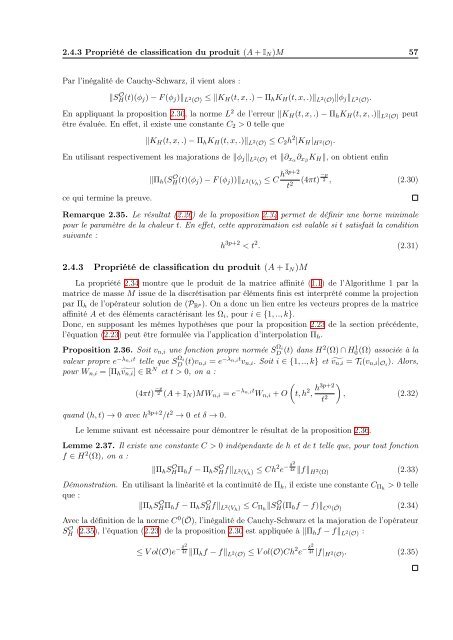Contributions à l'étude de la classification spectrale et applications
Contributions à l'étude de la classification spectrale et applications
Contributions à l'étude de la classification spectrale et applications
You also want an ePaper? Increase the reach of your titles
YUMPU automatically turns print PDFs into web optimized ePapers that Google loves.
2.4.3 Propriété <strong>de</strong> c<strong>la</strong>ssification du produit (A + IN)M 57<br />
Par l’inégalité <strong>de</strong> Cauchy-Schwarz, il vient alors :<br />
S O H(t)(φj) − F (φj) L 2 (O) ≤ KH(t, x, .) − ΠhKH(t, x, .) L 2 (O)φj L 2 (O).<br />
En appliquant <strong>la</strong> proposition 2.30, <strong>la</strong> norme L 2 <strong>de</strong> l’erreur KH(t, x, .) − ΠhKH(t, x, .) L 2 (O) peut<br />
être évaluée. En eff<strong>et</strong>, il existe une constante C2 > 0 telle que<br />
KH(t, x, .) − ΠhKH(t, x, .) L 2 (O) ≤ C2h 2 |KH| H 2 (O).<br />
En utilisant respectivement les majorations <strong>de</strong> φj L 2 (O) <strong>et</strong> ∂xα∂xβ KH, on obtient enfin<br />
ce qui termine <strong>la</strong> preuve.<br />
Πh(S O H(t)(φj) − F (φj)) L 2 (Vh) ≤ C h3p+2<br />
t 2 (4πt) −p<br />
2 , (2.30)<br />
Remarque 2.35. Le résultat (2.26) <strong>de</strong> <strong>la</strong> proposition 2.34 perm<strong>et</strong> <strong>de</strong> définir une borne minimale<br />
pour le paramètre <strong>de</strong> <strong>la</strong> chaleur t. En eff<strong>et</strong>, c<strong>et</strong>te approximation est va<strong>la</strong>ble si t satisfait <strong>la</strong> condition<br />
suivante :<br />
h 3p+2 < t 2 . (2.31)<br />
2.4.3 Propriété <strong>de</strong> c<strong>la</strong>ssification du produit (A + IN)M<br />
La propriété 2.34 montre que le produit <strong>de</strong> <strong>la</strong> matrice affinité (1.1) <strong>de</strong> l’Algorithme 1 par <strong>la</strong><br />
matrice <strong>de</strong> masse M issue <strong>de</strong> <strong>la</strong> discrétisation par éléments finis est interprété comme <strong>la</strong> projection<br />
par Πh <strong>de</strong> l’opérateur solution <strong>de</strong> (PRp). On a donc un lien entre les vecteurs propres <strong>de</strong> <strong>la</strong> matrice<br />
affinité A <strong>et</strong> <strong>de</strong>s éléments caractérisant les Ωi, pour i ∈ {1, .., k}.<br />
Donc, en supposant les mêmes hypothèses que pour <strong>la</strong> proposition 2.23 <strong>de</strong> <strong>la</strong> section précé<strong>de</strong>nte,<br />
l’équation (2.23) peut être formulée via l’application d’interpo<strong>la</strong>tion Πh.<br />
(Ω) associée <strong>à</strong> <strong>la</strong><br />
). Alors,<br />
Proposition 2.36. Soit vn,i une fonction propre normée S Ωi<br />
D (t) dans H2 (Ω) ∩ H1 0<br />
valeur propre e−λn,it Ωi<br />
telle que SD (t)vn,i = e−λn,itvn,i. Soit i ∈ {1, .., k} <strong>et</strong> vn,i = Ti(vn,i|Oi<br />
pour Wn,i = [Πhvn,i] ∈ R N <strong>et</strong> t > 0, on a :<br />
(4πt) −p<br />
2 (A + IN)MWn,i = e −λn,it Wn,i + O<br />
quand (h, t) → 0 avec h 3p+2 /t 2 → 0 <strong>et</strong> δ → 0.<br />
<br />
t, h 2 , h3p+2<br />
t2 <br />
, (2.32)<br />
Le lemme suivant est nécessaire pour démontrer le résultat <strong>de</strong> <strong>la</strong> proposition 2.36.<br />
Lemme 2.37. Il existe une constante C > 0 indépendante <strong>de</strong> h <strong>et</strong> <strong>de</strong> t telle que, pour tout fonction<br />
f ∈ H 2 (Ω), on a :<br />
ΠhS O HΠhf − ΠhS O Hf L2 (Vh) ≤ Ch 2 δ2<br />
−<br />
e 4t fH 2 (Ω)<br />
(2.33)<br />
Démonstration. En utilisant <strong>la</strong> linéarité <strong>et</strong> <strong>la</strong> continuité <strong>de</strong> Πh, il existe une constante CΠh > 0 telle<br />
que :<br />
(2.34)<br />
ΠhS O HΠhf − ΠhS O Hf L 2 (Vh) ≤ CΠh SO H(Πhf − f) C 0 (Ō)<br />
Avec <strong>la</strong> définition <strong>de</strong> <strong>la</strong> norme C0 ( Ō), l’inégalité <strong>de</strong> Cauchy-Schwarz <strong>et</strong> <strong>la</strong> majoration <strong>de</strong> l’opérateur<br />
SO H (2.35), l’équation (2.23) <strong>de</strong> <strong>la</strong> proposition 2.30 est appliquée <strong>à</strong> Πhf − fL2 (O) :<br />
δ2<br />
−<br />
≤ V ol(O)e 4t Πhf − fL2 (O) ≤ V ol(O)Ch 2 δ2<br />
−<br />
e 4t |f| H2 (O). (2.35)

















